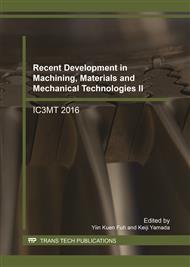p.124
p.130
p.136
p.141
p.148
p.154
p.161
p.171
p.178
The Investigation of Electrochemical Slurry Jet Micro Machining on the SKD11 Mold Steel
Abstract:
The electrochemical machining technology has unique processing characteristics, often used to machining the hard material. But electrochemical techniques applied to carbon steel or heat treatment after the material processing, surface generates a black layer after the processing that is carbon-rich layer. This layer is the product of a non-electrochemical reaction of precipitation that hinder the process, leading to reduced rate of electrochemical machining and increasing the surface roughness of workpiece. This study presents electrochemical micromachining combine abrasive slurry injection ways to improve electrochemical machining black layer problem. In this thesis, the hollow tube is used in 500 and 700μm, and the NaCl is chosen as the electrolyte to drill SKD11, and investigate the influence of different voltage, concentration, abrasive concentration, and electrode gap.
Info:
Periodical:
Pages:
148-153
Citation:
Online since:
August 2017
Authors:
Price:
Сopyright:
© 2017 Trans Tech Publications Ltd. All Rights Reserved
Share:
Citation:


